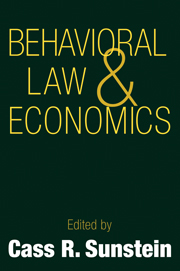Book contents
- Frontmatter
- Contents
- Contributors
- Acknowledgments
- Introduction
- Part I Overview and Prospects
- Part II Heuristics and Biases: Shortcuts, Errors, and Legal Decisions
- Part III Valuation: Values and Dollars in the Legal System
- 8 Experimental Tests of the Endowment Effect and the Coase Theorem
- 9 Assessing Punitive Damages (With Notes on Cognition and Valuation in Law)
- 10 Framing the Jury: Cognitive Perspective on Pain and Suffering Awards
- 11 Behavioral Economic Analysis of Redistributive Legal Rules
- 12 Do Parties to Nuisance Cases Bargain After Judgment? A Glimpse Inside the Cathedral
- Part IV The Demand for Law: Why Law Is As It Is
- Index
9 - Assessing Punitive Damages (With Notes on Cognition and Valuation in Law)
Published online by Cambridge University Press: 05 June 2012
- Frontmatter
- Contents
- Contributors
- Acknowledgments
- Introduction
- Part I Overview and Prospects
- Part II Heuristics and Biases: Shortcuts, Errors, and Legal Decisions
- Part III Valuation: Values and Dollars in the Legal System
- 8 Experimental Tests of the Endowment Effect and the Coase Theorem
- 9 Assessing Punitive Damages (With Notes on Cognition and Valuation in Law)
- 10 Framing the Jury: Cognitive Perspective on Pain and Suffering Awards
- 11 Behavioral Economic Analysis of Redistributive Legal Rules
- 12 Do Parties to Nuisance Cases Bargain After Judgment? A Glimpse Inside the Cathedral
- Part IV The Demand for Law: Why Law Is As It Is
- Index
Summary
The award of punitive damages has become one of the most controversial and important uses of the tort law, extending well beyond the common law to such statutory areas as environmental protection and employment discrimination. In recent years many people have objected that punitive damages are unpredictable, even “out of control.” Consider, as possible examples, a punitive award of $4 million for nondisclosure of the fact that the plaintiff's new BMW had been repainted, a $6 million punitive award for tortious interference with contractual relations, a $400 million punitive award for fraud by an owner of funeral homes, a $30 million punitive award for anticompetitive conduct, and a $2.7 million award, later reduced to $480,000, to a woman who spilled coffee on herself that McDonald's knew to be too hot. These are mere anecdotes, but there is more systematic evidence as well, suggesting a far from trivial degree of randomness, especially at the high end.
Our principal interest here is in identifying some of the sources of unpredictability in jury judgments. On the basis of a study of 899 jury-eligible citizens, we offer the following major findings:
1. People have a remarkably high degree of moral consensus on the degrees of outrage and punishment that are appropriate for punitive damage cases. At least in the products liability cases we offer, this moral consensus, on what might be called outrage and punitive intent, cuts across differences in gender, race, income, age, and education.
- Type
- Chapter
- Information
- Behavioral Law and Economics , pp. 232 - 258Publisher: Cambridge University PressPrint publication year: 2000
- 135
- Cited by



